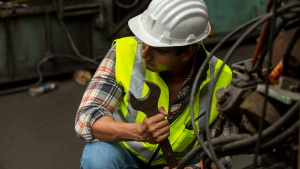The organization needs to understand that identifying and eliminating the risks and hazards that its employees are exposed to is fundamental both for their health and for the company’s performance.
Every organization needs to manage the risks to which its employees are exposed. ISO 45001, for example, brings into its context that the organization is responsible for the occupational health and safety of workers. As well as others who may be affected by their activities. This responsibility includes promoting and protecting people’s physical and mental health.
The standard also aims to prevent work-related injuries and health problems for workers and provide healthier workplaces. This certainly involves eliminating the dangers and minimizing the risks of OSH and always taking effective preventive measures.
To apply preventive measures related to risks and hazards, it is first necessary to understand what they are and what their differences are. Therefore, in today’s article we will address the following topic: differences between risks and hazards; and a little about its relationship with ISO 45001.
Definition of risks and hazards
Risk is the probability of an event happening. That is, the chance that something that affects your company will come to happen. Be it a threat, when it is negative; or an opportunity, when it is positive.
In the ISO 45001 standard – Occupational Health and Safety Management Systems, we can find the following definition for risk, corroborating the idea presented above:
Risk is the combination of the probability of occurrence of dangerous events or exposures related to work and the severity of injuries and problems that may be caused by the event(s) or exposure(s).
Risk is linked to hazard, which in turn is defined as the source, situation or event with the potential to cause damage to the employee’s health and physical integrity.
When the employee is exposed and vulnerable to a source of hazard, he is therefore “at risk”.
Some examples of hazard:
- Exposure to toxic chemicals and products;
- Lack of safety equipment or inappropriate equipment;
- Work environment with factors that cause damage to health (such as gasses, high or very low temperature)
- Environments with slippery floors
Types of Risk
Going a little deeper into the topic of risks, we can subdivide the risks. We can divide occupational risks into 5 groups, and they are:
Accident Risks:
These are all factors that can put the worker in a vulnerable situation and may affect their integrity, their physical and psychological well-being. For example, unprotected machinery and equipment, inadequate workplace layout, inadequate storage, etc.
Physical Risks:
Risks in the form of energy, such as noise, extreme temperatures, vibrations, ionizing radiation, non-ionizing radiation, cold, heat, abnormal pressures and humidity.
Biological Risks:
They are bacteria, viruses, fungi, parasites, among others.They depend on direct contact between the worker and some harmful biological substance.
Ergonomic Risks:
These are the risks that affect the worker’s psychophysiological health. We can mention physical exertion, weight lifting, inadequate posture, rigid control of productivity, stress situation, night shifts, long working hours, monotony and repetitiveness, imposition of an intense routine.
Chemical Risks:
The chemical risk corresponds to when the worker is exposed to substances, compounds or products that can penetrate the body. Whether through the respiratory route, in the form of dust, fumes, gasses, etc.; or even contact with the skin and other tissues.
Differentiating risk from hazard
After understanding the concepts of the difference between risk and hazard, let’s go for a practical example. A company that does not do maintenance of its forklifts, for example. These, in turn, have faults in their brake system. That is a hazard. It is a condition that can cause an accident. Brake failure is a hazard that can lead to a serious accident.
The risk is that a person is exposed to this hazard. In this case, the worker who drives the forklift and everyone else who is around the area in which it transits.
When the hazard of “brake failure” occurs, the risk is that the forklift will not be able to stop and thus hit someone, knock something over, lose control and hit several people.
You need to eliminate hazards to reduce risks
Hazard needs to be prevented, analyzed and eliminated, because it is through it that the risk is generated. Often, the treatment of risk is directly linked to the existence or not of the hazard.
This is where the well-known risk management comes in, management that can prevent, reduce or eliminate the impacts and probabilities of risks happening. In this way, it is possible to control the organization in relation to potential threats.
ISO 45001 also provides, in requirement 6.1.2.1, the following statement “the organization shall establish, implement and maintain a process for hazard identification that is proactive and continuous”.
That is, the organization needs to implement processes for the identification of hazards to later work on their treatment in search of a solution.
When an accident occurs with employees within a given organization, the damage is physical, material, financial and of image. Therefore, the organization needs to understand that identifying and eliminating the risks and hazards to which its employees are exposed is fundamental! Both for their health and for the company’s performance itself. It is only possible to achieve better results if people are healthy to do that!










